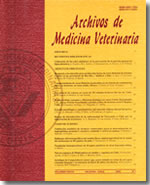Economics of eradicating Foot-and-Mouth disease epidemics with alternative control strategies
Main Article Content
Abstract
The paper presents an economic analysis of Foot-and-Mouth Disease (FMD) control strategies for livestock herds. Alternative vaccination-to-live control strategies were compared to the strategy that involves culling of all susceptible animals in an area of 1 km around infected herds in addition to standard measures as culling of infected herds, pre-emptive slaughter of contact herds, establishment of control and surveillance zones. Vaccination strategies differed with respect to the radius of vaccination around infected farms (2 km versus 5 km). As an example to illustrate the economic consequences the Netherlands was used. These strategies were evaluated for a Sparsely Populated Livestock Areas (SPLA) with less than 2 farms/km2 and a Densely Populated Livestock Areas (DPLA) with more than 4 farms/km2. Results of the partial budgeting FMD model revealed that for DPLA a control strategy which includes a vaccination radius of 2 km is most cost effective. For SPLA a control strategy which includes a 1 km culling radius around an infected farm is most cost effective.

